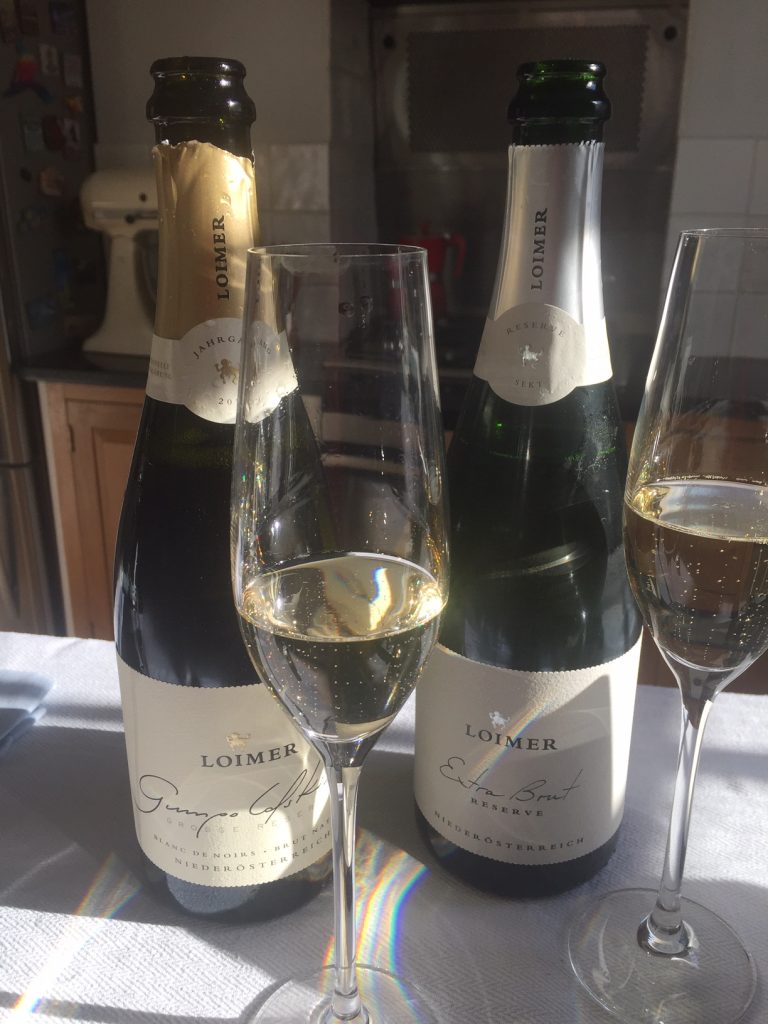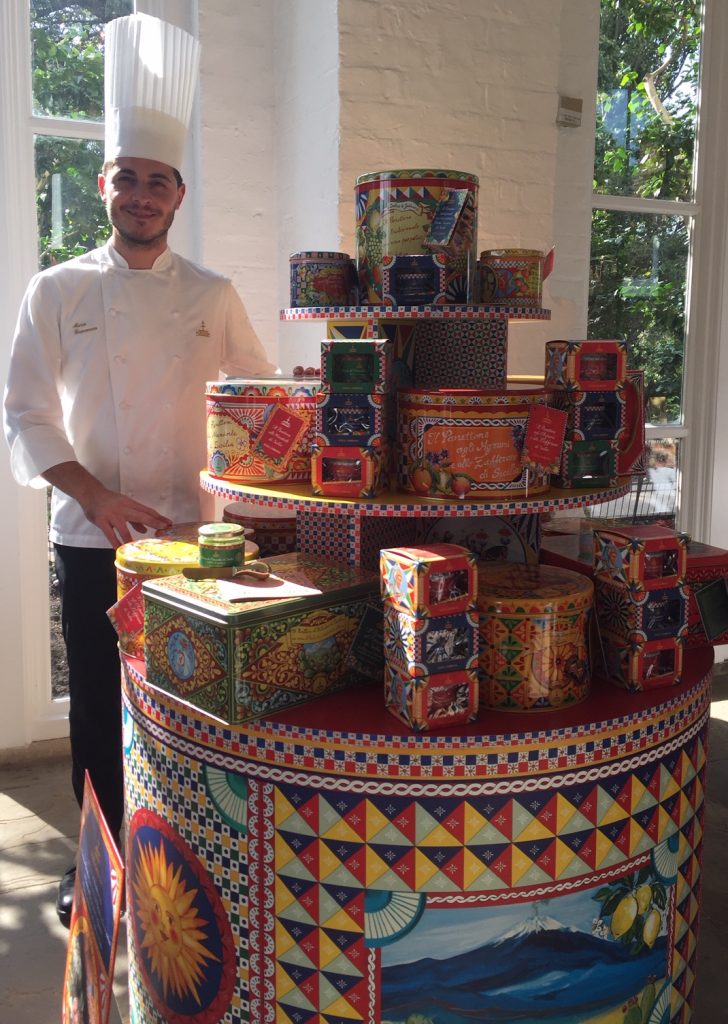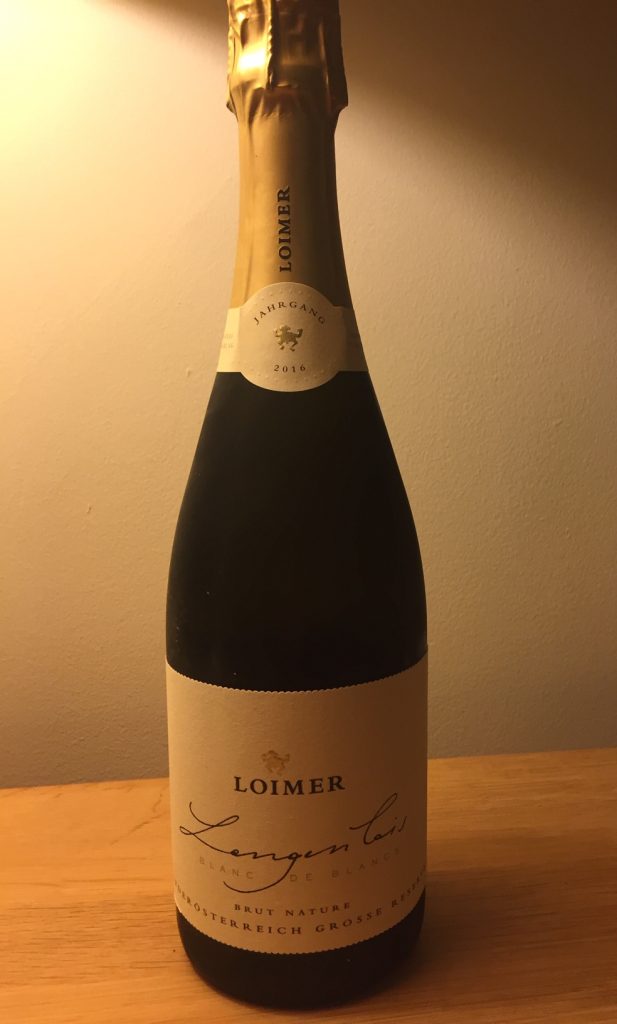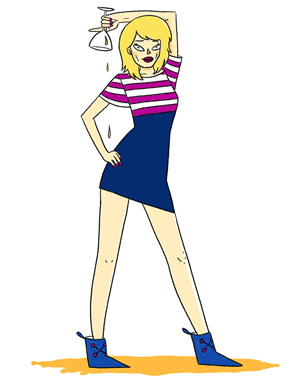bubbles & bread

I am very partial to Champagne – the good stuff, but it’s easy to fork out on Champagne and be disappointed. On the other hand, it’s a joy to discover delicious alternatives to traditionally method sparking wine and fun to share something a bit different with your friends.
One such wine appeared at my door sent by Fred Loimer who is among Austria’s most applauded winemakers. I tasted his recently released 2016 Grosse Reserva Sekt Blanc de Noir and was rather impressed. Austria may not readily come to mind for its fine sparking wines, but choose carefully and you will be pleasantly surprised.
In Austria there is quite a wide choice of grape varieties and some, including Riesling, are aromatic. I am not convinced by sparking wines with overtly scented characters. Chardonnay and Pinot Noir are ideal, but not very Austrian and thus rather detract from an Austrian sense of identity, but they are an excellent conduit to the terroir.
But first a few words about Sekt – Austria’s sparking wine. I have written about this in a previous blog, but just to recap. It’s pretty easy to understand the label. There are three tiers to the quality pyramid; classic is the simplest category from which you should expect something forward and crowd pleasing. This can be made by the Charmat method (used for Prosecco) and must have nine months ageing on lees. Reserve is a step up to a bottle fermented wine requiring 18 months ageing. Finally the top tier Grosse Reserve should deliver something in the ball part of a really rather good Champagne.
For each level there are production regulations including hand picking, whole bunch pressing and time maturing on the lees. Like many good producers Loimer goes well beyond the statutory demands. For example his non-vintage Extra Brut Reserve has a full three years on lees. It was no surprise to hear Loimer describing his process of harvesting – picking the grapes into small boxes which are tipped directly into the press, thus protecting the integrity of the grape. The attention to detail is reflected in his wine.

Loimer Extra Brut Reserve
This is generous, quite full bodied, rather luscious and almost buttery, while having a nice dry finish. The extra lees ageing is responsible for the finesses of the bubbles, but also the richness and depth. This wine delivered lots up front, in comparison with the more reserved Grosse Reserve, but as the wines developed in the glass, the latter was the clear front runner.
Loimer Gumpoldskirchen Grosse Reserve Blanc de Noirs 2016
A lightly smoky aroma with a hint of burnt toast. This is straight and well defined with compact energy and good length. There is focus and precision. It is quite quiet, but there is power which carries the dry and saline finish. There is also an undertone of appetisingly caramelised, almost bitter umami.
The Grosse Reserve comes from the ‘Burgundy’ of Austria – and area East of the Alps called Gumpoldskirchen. Loimer describes an East facing limestone slope with the vines planted on the bottom third.
He arrived in 2013 to plant Pinot Noir and Chardonnay for still wine. At the time he felt Gumpoldskirchen had ‘the perfect temperature’. Now with climate change it is getting a little too warm for Pinot Noir and Loimer picks earlier and includes 100% of stems in his Pinot Noir for freshness. (Although the Pinot Noir for his sparking is whole bunch pressed like a white wine).
Loimer explained that the earlier ripening is not only due to climate change, but to biodynamics. He remarks that the vine’s shoots are shorter and grow more slowly than in a conventionally managed vineyard. “The vine focuses on growth before flowing and subsequently on ripening, which happens earlier. My vineyard will be brown by autumn, while the conventionally managed will still be green. This has all be measured by the University of Geisenheim.”
(I’d be concerned that this quicker ripening together with warmer summers might make the region increasing unsuitable to make a base wine for a fine bottle of fizz. But on the positive side it is well documented that biodynamic viticulture producers grapes with good acidity – actually a lower and more stable pH – so it seems likely Loimer’s grapes will retain their freshness.)
Loimer is a founding member Respekt the biodynamic organisation which I wrote about in a blog last year. He stresses the importance of making his own compost and teas at the domaine to nourish and treat the vines. He finds this enhances the expression of terroir in the wine. The yeasts and bacteria on the grapes are carried to the winery and help to create a spontaneous and clean fermentation and of course the lees influence the character, favour and texture of the finished wine. Both the wines above have an initial ageing in large older oak casks. Both go though a full malolactic, which contributes to the complexity, but also makes them more stable. Hence just a touch of SO2 is necessary at bottling.
Loimer also makes a Blanc de Blanc from Langenlois in Kamtal which lies to the North West. This is a cooler region with a greater diurnal temperature. Here we are told the soil is lighter. The wine is certainly fresh and straight, stylish with a true sense of place.
Loimer Langenlois Grosse Reserve Blanc de Blancs 2016
Crystalline with a direct, fine, light, vibrant and rather salty palate. The palate is well edged and the mouse fine. I really liked this.
You will often hear producers of fine wine speaking of their pursuit of the expression of terroir. Even in Champagne, which has a cast iron regional identity and where blending is typical to create a consistent house identity, there is a trend for single vineyard wines.
Arguably the expression of terroir is more difficult to achieve in sparking wine as the secondary fermentation and lengthy lees ageing distances the wine from the terroir. But where there there is no great tradition of making sparkling wine, it makes sense to home in on expressing the identity of the site. It gives the wine another layer of interest.
Certainly you will hear producers of English bottle fermented sparking wine extolling the influence of the soil and topography of their vineyards. And why not. The chalky soils of the South Downs are dotted with vineyards and if you have not tried the wines of Ambriel, you should. Just a few miles away you will find Wiston Estate.
Wiston Estate Blanc de Blancs Brut, 2014
Rich biscuits aroma.The palate is fresh and energetic. I like the brioche notes and slight marmite bite on the finish which is well sustained. (Available from Swig)
While the cool chalky downloads of West Sussex bear some resemblance to the hills of Champagne making them a good bet for a quality fizz, I was intrigued to be presented with a traditional method sparkling wine from Macedonia in Greece. It is made from Xinomavro, a quality indigenous variety with some similarities to Pinot Noir.
Domaine Karanika, Brut Reserve 2015
This really packs a punch with a dense and rather compact palate. A burly wine for sure. The same domain make a Cuvée Speciate also from Xinomavro, which is lighter and brighter, but less intense and less expensive. (Available from Maltby & Greek)
This is certainly a sparking wine with the structure to accompany a meal. And on that point, don’t consign a traditional method sparking wine to the aperitif or party slot. In Austria, Fred Loimer explains that sekt is more often paired with food than not. This might be at the beginning of a meal with a first course, but equally as a refreshing wine towards the end of a meal. However a rosé can have the firm structure to take on the main course with the proviso of a low dosage. Often roses are too sweet, but Loimer’s is bone dry at 2g/l. Loimer Brut Rosé Reserve NV has the structure and weight to partner fish and more delicate dishes of chicken.
This brings to mind a tasting I tootled along to in the orangery in Holland Park last August. It was perfect summer’s day and I went expecting to taste wine, but was presented with an array of delicious Italian food specialities by the specialist importer Cibosano. These were gently washed down with a glass of prosecco.
Among the tasty treats there were several panettone, but no ordinary panettone. These were made by master pastry chef Nicola Fiasconaro, who was there in person making his panettone into other delicious sweet creations. I had to taste them.

Nicola explained that panettone originated in Milan. However in 1953 his grandfather, Mario, set out to make a truly Sicilian version with local ingredients. These include the hazelnuts of Madonie, a mountain ridge above Palermo, and manna, a sugary sap from the bark of ash trees.
The Fiasconaro clan live in the Madonie with rather illustrious neighbours – the Dolce family (yes, of Dolce and Gabbana fame). Nicola explains how he and Dolce grew up together and shared a dream to show the Italy – and the world – the very best of Sicilian creativity.
In the fullness of time, having become an international fashion icon, Dolce offered to deign the packaging for his friend’s panettone. The panettone have become every more creative over the years and I can vouch for their scrumptiousness and the sheer delight of the tins designed by Dolce.
With Easter approaching, it would make a wonderful gift; an alternative to chocolate, but don’t consign panettone to festive occasions. It’s a delicate sweet bread to have at any time of year. I find this light and airy treat is perfect for a warm spring or summer’s day accompanied by a glass of sparking wine.
Just to round things off, I would recommend serving a light airy and buttery slice of Nicola Fiasconaro Panettone with a glass of Loimer Langenlois Grosse Reserve Blanc de Blancs 2016.


